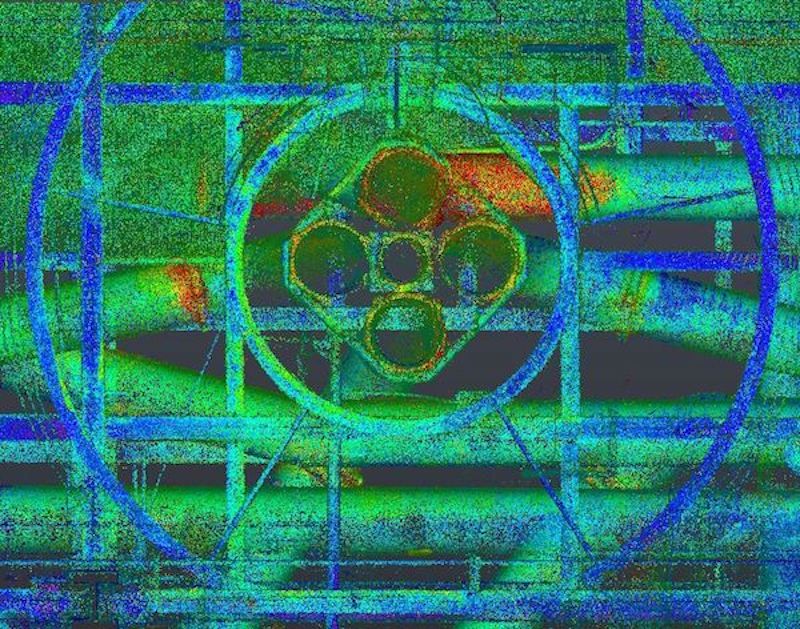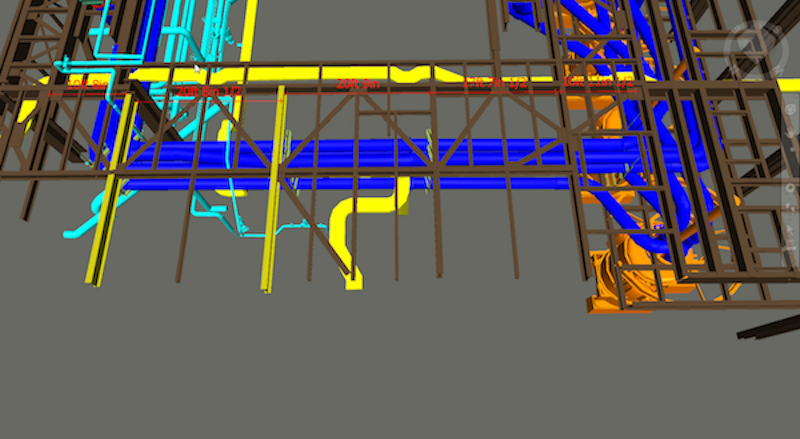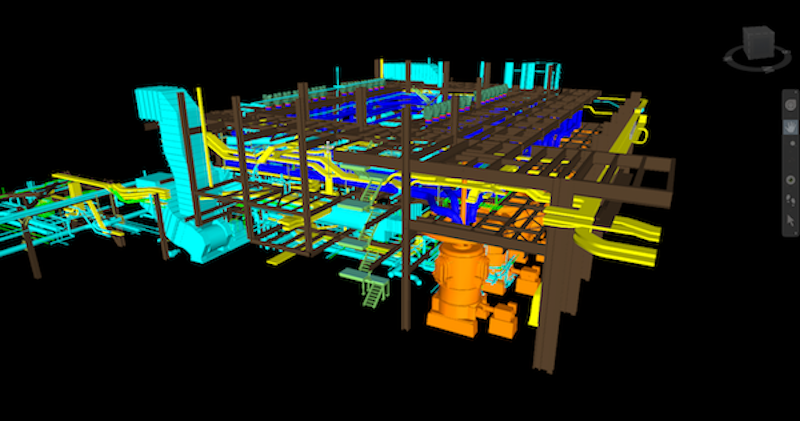Plant Bowen, a coal-fired power station owned by Georgia Power Company in Euharlee, Ga., needed to undergo an ambitious demolition and replacement of its Unit-4 fuel pipe. Coal dust, which is the consistency of talcum powder, is blown through the fuel pipe from the pulverizer for ignition. In order to tackle the challenging and inherently dangerous project, Georgia Power called upon Acensium to provide engineering support and take on the piping digitization to support demolition and installation/construction teams (Contractor: Zachary; Fabrication: JMS). Among the main issues the project faced was that the fuel pipe was confined by structural members, floor members, plant equipment, and the boiler itself with little clearance to perform the work. The looming question was how to remove the old pipe from the building and get the new pipe installed.
Acensium is an engineering consulting services firm with a focus on material handling retrofit projects and 3D scanning for as-built reality capture, originally founded in 2003 in Denver, Colorado. The team was able to successfully assess the difficult project and plot a course of action by tapping into its expertise providing engineering and intellectual services, operations, consulting and engineering support primarily for the power, steel and paper industries throughout the United States.
 Cross section of single pulverizer outlet. FARO point cloud in Recap using the intensity filter.
Cross section of single pulverizer outlet. FARO point cloud in Recap using the intensity filter.
CHALLENGES
The multi-million dollar project—the demolition and replacement of the #4 fuel pipe—included millions of dollars in erected scaffolding alone, as well as a 141-man crew, 7-day-a-week work schedule and 35 days of plant “outage time” to do the work within. Plans specified a completion timeframe of one year from the planning stage.
What made this project particularly challenging was that it necessitated working next to a boiler with an ambient temperature of 120 degrees F. The facility was built around the equipment so everything was a tight fit.
- Our first job for Bowen had an area of concern 20ft X 20ft x 20ft.
- This Bowen fuel pipe project encompasses a huge volume (sqft) (and a huge amount of data) 80ft x 300ft x 300ft.
Furthermore, this was a high-heat/high-hazard environment with high noise levels and large amounts of vibration in addition to the huge volume to scans. The complex project required specialized safety training, insurance requirements and background checks as it was not a standard industrial environment, including the need for scans to be taken just feet from a boiler with an internal temperature of over 1500 degrees F.
SOLUTIONS
As a result of recent successes on multimillion dollar projects and digital visualization for Georgia Power, plant management requested Acensium’s involvement during the planning phase. Acensium demonstrated what would be able to be done with example scans to illustrate for project leads what was possible. Georgia Power recognized that the project could not be accomplished without 3D scanning project control and so Acensium utilized the FARO® Focus Laser Scanners and SCENE Software.
Had more traditional methods been used instead, the process would have included arduous and time-consuming tasks of measurements, estimation and guesswork to determine what changes had been made since the original design from decades ago. As a typical project team cannot simply look at 2D as-built drawings and understand the full scope of what is going on, the use of 3D scanning gives insight to the whole team. With a building constructed around the equipment, clearances are at a minimum. Understanding the operation and arrangement of every pipe and support was crucial for project success.
With a facility that has been literally built around installed power plant equipment in 1975, everything had to be mapped for success. There were no clearances designed-in for removal or addition of components as you would see in a facility built before equipment is installed. Every support beam, pipe, bracket and bolt needed to be accounted for to ensure that components can come out of (and into) the facility as needed. For example, a 50-foot pipe may need to be replaced in 10-foot sections instead of the original 50-foot solid length. There may simply be no way to get 50 feet of pipe into the building if not sectioned out. To that end, FARO 3D scanning technology, coupled with a highly skilled team, was paramount.
Jason Adkins, Principal at Acensium, says, “The skills and experience of personnel is key. You have to have great equipment, but behind that equipment is an engineering mind. To be able to provide engineering consulting and support effectively on jobs like this, it takes a high-level industry expert. The 3D scanning, modeling and visualization then allows you to communicate that expertise to every project stakeholder.”
 Hoist rail beam spacing shown in Navisworks, models developed in Cyclone and Revit.
Hoist rail beam spacing shown in Navisworks, models developed in Cyclone and Revit.
The Modeling Aspect
Dynamic visualization was used to show parts moving in and out of the constricted project area. The modeling was a mix of clash detection and project process planning. Visualization was also used to enhance communication between project stakeholders.
It should be noted that Acensium was called in late in the process. Typically, Acensium is present from day one of planning. Scans started only 48 hours before the scaffolding build-out began. The scanning had to be completed before the scaffolding blocked key viewpoint angles. Acensium’s team worked around the clock to get the initial as-built scanning done. Modeling and visualization support throughout demolition and installation processes allowed the team to account for unforeseen issues. Additional scans of specific areas can be taken, if needed, to resolve an issue.
Workflow Details
FARO Focus hardware and settings dealt with constant high vibrations. Care had to be taken in a high-heat environment with human exposure-time. FARO equipment operated for hours in a high-heat environment at 120 degrees F to produce key scans.
RESULTS
Final Deliverables
Final deliverables included model point-cloud overlay, engineering support and project control throughout the project — planning through completion.
Time and Costs Savings
While it is nearly impossible to measure exactly the time saved, it can safely be stated that if modeling had not been performed, many unforeseen issues would have occurred. For instance, it takes 22 man-hours to weld one joint. Rigging a pipe to be picked up takes 12 man-hours. If done incorrectly, it has to be disconnected and another pipe rigged. Easily, 1500+ man-hours were saved in avoided risk. Without visualization, 20% cost overruns would not be unheard of.
CONCLUSION
Since 2009, Acensium has had numerous projects through Georgia Power, including six prior laser-scanning-based coal-handling projects at Bowen plant. As a testament to the client’s satisfaction with the work completed, recurring business through Bowen is expected to continue, with new projects currently in the works.
For more information, visit www.acensium.com.
![]()
Related Stories
| Aug 11, 2010
Turner edges out Perkins+Will for the top spot on BD+C's Top 200 Building Team LEED APs ranking
With 1,006 LEED Accredited Professionals on staff, Turner Construction took the top spot on Building Design+Construction’s 2009 ranking of AEC firms with the most LEED APs, published as part of the Giants 300 report. Turner added more than 580 LEED APs during the past year to surpass Perkins+Will, which held the top spot four years running.
| Aug 11, 2010
Guggenheim and Google team up on shelter design competition
The Solomon R. Guggenheim Museum and Google yesterday announced the launch of Design It: Shelter Competition, a global, online initiative that invites the public to use Google Earth and Google SketchUp to create and submit designs for virtual 3-D shelters for a location of their choice anywhere on Earth. The competition opened on June 8, 2009, in honor of Frank Lloyd Wright’s birthday, and closes to submissions on August 23.
| Aug 11, 2010
EwingCole to merge with healthcare specialist Robert D. Lynn Associates
EwingCole, a nationally recognized architectural, engineering, interior design, and planning firm with more than 320 professionals, today announced that it will combine its practice with Robert D. Lynn Associates of Philadelphia, a 40-person firm with a robust portfolio of healthcare projects. The combination will create the Delaware Valley¹s largest and most comprehensive firm with an emphasis on healthcare architecture, and a national scope and presence.
| Aug 11, 2010
Jacobs, Arup, AECOM top BD+C's ranking of the nation's 75 largest international design firms
A ranking of the Top 75 International Design Firms based on Building Design+Construction's 2009 Giants 300 survey. For more Giants 300 rankings, visit http://www.BDCnetwork.com/Giants
| Aug 11, 2010
BIM adoption rate exceeds 80% among nation’s largest AEC firms
The nation’s largest architecture, engineering, and construction companies are on the BIM bandwagon in a big way, according to Building Design+Construction’s premier Top 170 BIM Adopters ranking, published as part of the 2009 Giants 300 survey. Of the 320 AEC firms that participated in Giants survey, 83% report having at least one BIM seat license in house, and nearly a quarter (23%) have 100-plus seats.
| Aug 11, 2010
Architecture Billings Index flat in May, according to AIA
After a slight decline in April, the Architecture Billings Index was up a tenth of a point to 42.9 in May. As a leading economic indicator of construction activity, the ABI reflects the approximate nine to twelve month lag time between architecture billings and construction spending. Any score above 50 indicates an increase in billings.
| Aug 11, 2010
Architecture Billings Index drops to lowest level since June
Another stall in the recovery for the construction industry as the Architecture Billings Index (ABI) dropped to its lowest level since June. The American Institute of Architects (AIA) reported the August ABI rating was 41.7, down slightly from 43.1 in July. This score indicates a decline in demand for design services (any score above 50 indicates an increase in billings).
| Aug 11, 2010
RTKL names Lance Josal president and CEO
Lance K. Josal FAIA has been named President and CEO of RTKL Associates Inc., the international planning, design and engineering firm. Josal succeeds RTKL’s current President and CEO, David C. Hudson AIA, who is retiring from the firm. The changes will take effect on 1 September 2009.
| Aug 11, 2010
Billings at U.S. architecture firms exceeds $40 billion annually
In the three-year period leading up to the current recession, gross billings at U.S. architecture firms increased nearly $16 billion from 2005 and totaled $44.3 billion in 2008. This equates to 54 percent growth over the three-year period with annual growth of about 16 percent. These findings are from the American Institute of Architects (AIA) Business of Architecture: AIA Survey Report on Firm Characteristics.
| Aug 11, 2010
Potomac Valley Brick launches brick design competition with $10,000 grand prize
Potomac Valley Brick presents Brick-stainable: Re-Thinking Brick a design competition seeking integrative solutions for a building using clay masonry units (brick) as a primary material.







